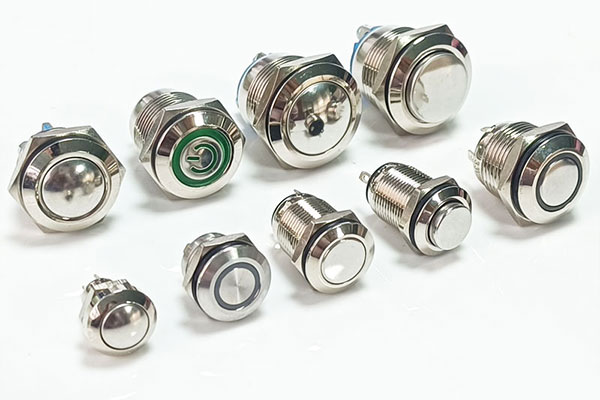Metal pushbutton switches are commonly used in various applications due to their durability, reliability, and aesthetic appeal. The materials used in the construction of these switches play a crucial role in their performance and longevity. Here's an in-depth look at the materials typically used in metal pushbutton switches:
Materials Used in Metal Pushbutton Switches

1. Housing and Actuator
The housing and actuator are the external parts of the pushbutton switch that are exposed to the environment and physical interaction. They are typically made from robust and durable metals, such as:
Stainless Steel: This is one of the most popular materials for metal pushbutton switches due to its high resistance to corrosion, strength, and appealing finish. Stainless steel switches are often used in harsh environments where exposure to moisture, chemicals, or extreme temperatures is common.
Aluminum: Aluminum is lightweight yet strong and corrosion-resistant, making it a good choice for applications where weight is a concern. It can be anodized to enhance its corrosion resistance and to offer various color finishes for aesthetic purposes.
Brass: Brass is known for its excellent conductivity and corrosion resistance. It is often used in applications where electrical conductivity is important. Brass switches can be coated or plated with other metals like chrome or nickel to enhance their durability and appearance.
2. Internal Components
The internal components of metal pushbutton switches include the contacts, springs, and other mechanisms that facilitate the switch's operation. These parts are typically made from:
Copper: Copper is widely used for electrical contacts due to its excellent electrical conductivity. However, pure copper can tarnish and oxidize, so it is often plated with other metals such as silver or gold to improve its performance and longevity.
Silver: Silver is used for contacts because of its superior conductivity and resistance to oxidation. Silver-plated contacts provide reliable performance over a long period, making them suitable for high-reliability applications.
Gold: Gold-plated contacts offer the best resistance to oxidation and corrosion, providing extremely reliable and long-lasting performance. However, gold is expensive, so it is typically used in high-end or specialized applications where reliability is critical.
Phosphor Bronze: This alloy, which includes copper, tin, and phosphorus, is used for springs and contact elements due to its excellent elasticity, fatigue resistance, and corrosion resistance.
3. Seals and Insulators
To ensure the pushbutton switch operates reliably in various environments, seals and insulators are used to protect the internal components from dust, moisture, and other contaminants. These materials include:
Silicone Rubber: Silicone rubber is commonly used for sealing due to its flexibility, temperature resistance, and durability. It provides an effective barrier against moisture and dust, ensuring the switch's internal components remain protected.
EPDM (Ethylene Propylene Diene Monomer): This synthetic rubber is used for seals and gaskets because of its excellent resistance to weathering, ozone, and various chemicals.
Plastic Insulators: High-quality plastics such as polycarbonate or nylon are used as insulators within the switch to prevent electrical shorts and to support the internal components. These materials are chosen for their electrical insulating properties, strength, and resistance to heat and chemicals.
Conclusion
The materials used in metal pushbutton switches are carefully selected to provide durability, reliability, and resistance to environmental factors. Stainless steel, aluminum, and brass are commonly used for the housing and actuator due to their strength and corrosion resistance. Copper, silver, and gold are used for internal contacts to ensure excellent electrical conductivity and longevity. Seals and insulators made from silicone rubber, EPDM, and high-quality plastics protect the internal components and ensure the switch operates reliably in various conditions. By understanding these materials, users can choose the right pushbutton switch for their specific applications.
Contact: Ms Bella
Phone: +86-15999819066
Tel: +86-0769-89615395
Email: Bella@fvwin.com
Add: No 25, Xinfeng East Road, Shijie Town, Dongguan, GD, CN, 523000
We chat
